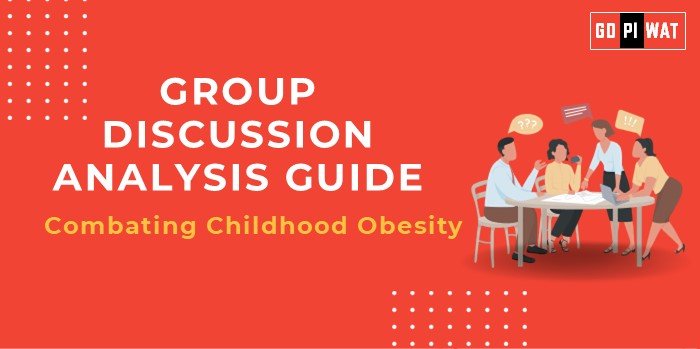📋 Group Discussion (GD) Analysis Guide: Addressing Childhood Obesity
🌐 Introduction to the Topic
Childhood obesity is recognized as a growing global public health concern. According to the World Health Organization (WHO), it affects over 39 million children under the age of five worldwide, highlighting its widespread prevalence and impact on public health systems.
The alarming rise in childhood obesity rates over the last two decades has been fueled by unhealthy dietary habits, reduced physical activity, and socio-economic inequalities. Public health stakeholders globally are now emphasizing preventive measures and policy reforms to combat this crisis.
📊 Quick Facts and Key Statistics
- 🌍 Global Prevalence: 39 million children under five were overweight or obese in 2022 (WHO).
- 💰 Economic Impact: Obesity-related healthcare costs could reach $2 trillion annually worldwide by 2030 (McKinsey Global Institute).
- 🍭 Dietary Trends: 70% of children consume more than the recommended amount of sugar daily (CDC, 2023).
- 🏃 Physical Inactivity: Less than 25% of children meet the WHO-recommended one hour of daily physical activity.
👥 Stakeholders and Their Roles
- Government Agencies: Develop policies for healthier school lunches, regulate advertising for unhealthy foods, and fund public awareness campaigns.
- Healthcare Providers: Monitor and treat obesity-related health conditions and provide family-based counseling.
- Schools: Promote physical education, provide balanced meals, and integrate health education into curriculums.
- Parents and Guardians: Foster healthy eating habits and encourage active lifestyles at home.
- Food and Beverage Industry: Reformulate products to reduce sugar, salt, and fat content and ensure responsible marketing practices.
🎯 Achievements and Challenges
Achievements:
- ✅ Policy Interventions: Countries like Mexico and the UK have implemented sugar taxes, leading to reduced consumption of sugary drinks.
- ✅ Awareness Campaigns: Initiatives such as “Let’s Move!” in the U.S. have successfully increased physical activity awareness.
- ✅ Improved Data Monitoring: Global nutrition reports now include extensive data on childhood obesity, aiding in targeted policy interventions.
Challenges:
- ⚠️ Socioeconomic Inequalities: Low-income families often lack access to healthy foods and recreation facilities.
- ⚠️ Marketing of Unhealthy Foods: Aggressive marketing campaigns continue to target children, promoting calorie-dense, nutrient-poor foods.
- ⚠️ Cultural Barriers: Misconceptions about healthy body weight and dietary habits persist in many societies.
Global Comparisons:
- 🌟 Success: Japan’s “Shokuiku” (food education) program emphasizes balanced diets, contributing to one of the lowest childhood obesity rates globally.
- ⚠️ Challenges: The U.S. faces one of the highest childhood obesity rates, with nearly 1 in 5 children affected (CDC, 2023).
📜 Structured Arguments for Discussion
- Supporting Stance: “Childhood obesity is a severe public health crisis, demanding urgent global intervention due to its health, economic, and social implications.”
- Opposing Stance: “Childhood obesity, though significant, is not a crisis; better education and personal responsibility can manage it without overstating its impact.”
- Balanced Perspective: “While childhood obesity poses substantial challenges, a coordinated effort across public and private sectors can effectively mitigate its risks.”
🗣️ Effective Discussion Approaches
- Opening Approaches:
- 📈 Statistical Opener: “One in five children globally is obese, placing significant strain on healthcare systems.”
- 🌍 Case Study: “Mexico’s sugar tax led to a 12% drop in sugary drink sales within a year, showcasing policy effectiveness.”
- ⚖️ Contrast: “Despite health advancements, childhood obesity continues to escalate due to lifestyle changes.”
- Counter-Argument Handling:
- Use data to counter skepticism.
- Suggest evidence-based policies like sugar taxes or school meal reforms.
🔍 Strategic Analysis of Strengths and Weaknesses
- Strengths: Strong data availability, successful pilot programs (e.g., sugar taxes).
- Weaknesses: Lack of universal policies and enforcement mechanisms.
- Opportunities: Integrating AI to monitor health trends and expanding public-private partnerships.
- Threats: Growing influence of fast-food culture and reduced physical activity due to digital consumption.
🎓 Connecting with B-School Applications
- Real-World Applications: Link obesity to healthcare management, public policy analysis, or consumer behavior studies.
- Sample Interview Questions:
- “How can public health systems address childhood obesity sustainably?”
- “What role do businesses play in combating childhood obesity?”
- Insights for B-School Students: Explore intersections of health and business, such as CSR initiatives or sustainable food marketing.


